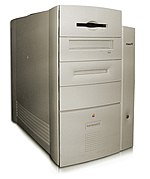Power Macintosh G3 AIO

The Beige Power Macintosh G3.
|
|
| Developer | Apple Computer Inc. |
|---|---|
| Type | Desktop (Minitower) |
| Release date | November 10, 1997 |
| Introductory price | $1599 |
| Discontinued | January 5, 1999 |
| CPU |
PowerPC G3, 233 – 333 MHz |
| Predecessor | Power Macintosh 8600 |
| Successor | Power Macintosh G3 (Blue & White) |
The Power Macintosh G3, commonly called "beige G3s" or "platinum G3s" for the color of their cases, is a series of personal computers designed, manufactured, and sold by Apple Computer from November 1997 to January 1999. It was the first Macintosh to use the PowerPC G3 (PPC750) microprocessor, and replaced a number of earlier Power Macintosh models, in particular the 7300, 8600 and 9600 models. It was succeeded by the Power Macintosh G3 (Blue & White), which kept the name but introduced a radically different design. The introduction of the Desktop and Minitower G3 models coincided with Apple starting to sell user-configurable Macs directly from its web site in an online store, which was unusual for the time as Dell was the only other major manufacturer then doing this.
The Power Mac G3 introduced a fast and large Level 2 backside cache to Apple's product lineup, running at half processor speed. As a result, these machines were widely considered to be faster than Intel PCs of similar CPU clock speed at launch, an assertion that was backed up by benchmarks performed by Byte magazine, which prompted Apple to create the "Snail" and "Toasted Bunnies" television commercials.
The Power Macintosh G3 was originally intended to be a midrange series, between the low-end Performa/LC models and the six-PCI slot Power Macintosh 9600. It is the earliest Old World ROM Macintosh model officially able to boot into Mac OS X, and one of only two Old World ROM models able to boot into Mac OS X, the other model being the early PowerBook G3.
Apple developed a prototype G3-based six-slot full tower to be designated the Power Macintosh 9700. Despite demand from high-end users for more PCI slots in a G3 powered computer, Apple decided not to develop the prototype (dubbed "Power Express") into a shipping product, leaving the 9600 as the last six-slot Mac Apple would ever make.
...
Wikipedia
